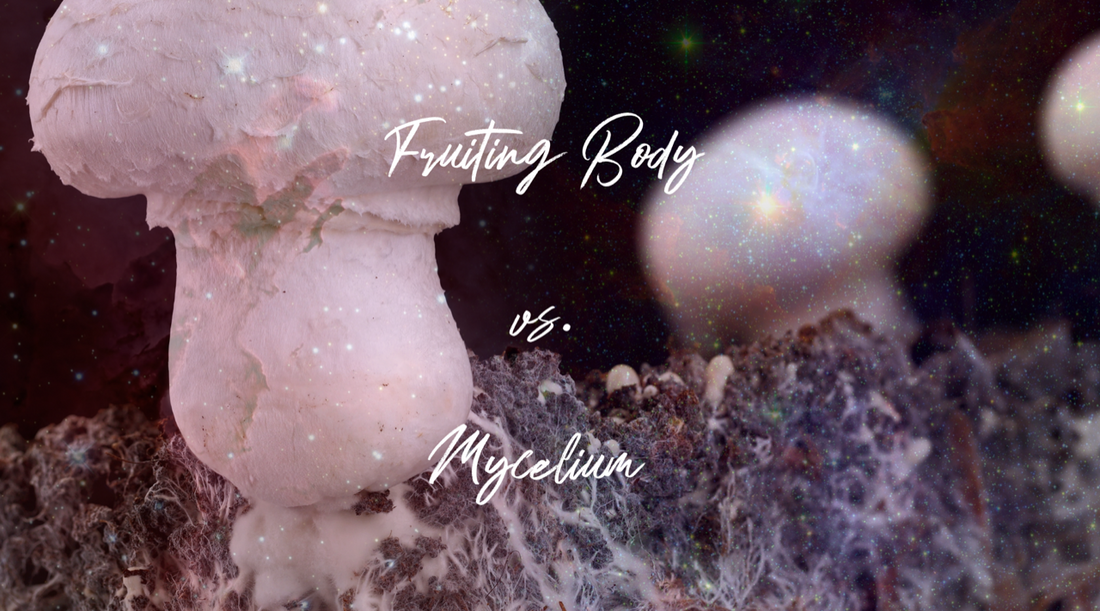
Fungi. The mere utterance of the word might conjure images of those umbrella-shaped munchies that tag along with your pizza or the green fluff that heralds the end of last week's bread. But hang tight, Houston, we've got no problems here, just solutions—especially when we're exploring the world of fungi, the unsung heroes of our ecosystem. This cosmic kingdom is so ancient and vital (some of the oldest species on our planet), that it’s like the dark matter holding our ecological galaxies together. Fungi is uber-diverse and intricate. So, what makes them this important? Two distinguished structures: fruiting bodies and mycelium. Think of them as the sun and the moon in the celestial dance of fungi—visible yet mysterious and essential for life as we know it.
So, what are these superstars? Those umbrella-shaped munchies and caps you see in the store are the fruiting bodies. But what you may never see is a secret society, an underground Silk Road if you will, known as the mycelium. This shadowy network isn't trading spices, but it's doing something arguably more valuable: sustaining life and giving fungi their slay. It's time to launch into the unique quirks and features of these two wonders and understand their contributions.
FRUITING BODIES OF FUNGI: THE ABOVE-GROUND STARS
What are fruiting bodies and what do they do?
Fruiting bodies are the fungal rockstars you’re most likely to recognize—those delectable or sometimes dodgy mushrooms sprouting in a forest or sitting pretty in a produce aisle. Their main job, the 9-to-5 you could say, is reproduction. Each body produces and releases spores, which are like the seeds of the fungal world. Once these spores find a new gig—say, a cozy patch of soil or a decomposing log—they start growing into new fungi. 
Many of the health-boosting properties we attribute to mushrooms, like immune-supporting beta-glucans in Reishi and Shiitake varieties (both found in our Breakthrough drink mix), come from these fruiting bodies.* So, the next time you're in the supermarket pondering over which mushrooms to take home, just remember: you're not just grocery shopping; you're adopting potential wellness warriors! (To learn more about the potential health attributes of these bodies, check out the science behind PeakO2 mushroom blend.)
Ecosystem & Sustainability
Fruiting bodies are the tip of the iceberg regarding the ecological symphony in which fungi participate.
- By releasing spores, they play a key role in biodiversity, ensuring that fungi continue to proliferate across diverse habitats. This is vital for soil health and nutrient cycling, essential elements in sustainable ecosystems.
- Through symbiotic relationships with plants, some types of fruiting bodies aid in the uptake of nutrients and water, essentially serving as a natural irrigation and fertilization system.
- Their role in the ecosystem positions them as crucial players in climate change mitigation by promoting forest resilience and soil carbon storage.
FYI: You may or may not know that NOVA is big on supporting causes that promote advancements in environmentalism.
MYCELIUM: THE UNSUNG UNDERGROUND HERO
What is Mycelium and what does it do?
If fruiting bodies are the star quarterbacks, mycelium is the offensive line. Largely invisible but oh-so-important. Mycelium is a sprawling underground network of minuscule, thread-like structures known as hyphae. Think of it as fungi's roots, their underground internet, connecting various parts but with less cat videos and more nutrient exchange. It functions as the life-support system that fuels the growth of the fruiting body, acting like the nutritional bank and communication hub of the fungal universe (yes, mushrooms can slide into each other’s DM’s). Most importantly, mycelium is the primary structure of the fungus.
Most supplements use mycelium because it's easier to cultivate and harvest than fruiting bodies. However, it's essential to note that the concentration of beneficial compounds can vary between the mycelium and the fruiting body, depending on the mushroom. The good news is that Breakthrough’s mix contains both the fruiting and mycelium bodies! And that, our NOVA souls, is an extreme rarity in today’s supplement industry.
Ecosystem & Sustainability
Mycelium is the backbone of many ecosystems, acting as a biological "glue" that holds everything together.
- It is the recycling champ of the natural world, breaking down organic materials such as dead trees and leaves, and converting them into fertile soil.
- Its role in decomposition and nutrient cycling is vital for soil health, contributing to both land and water quality.
- The mycelial network forms symbiotic relationships with plant roots, enhancing nutrient absorption and even helping plants communicate with each other, like an underground social network for trees.
- These interactions boost plant health and resilience, contributing to more robust ecosystems capable of sequestering more carbon—a definite plus in our fight against climate change.
- Researchers are exploring mycelium’s ability to break down pollutants, raising the prospect that it could be a secret weapon in environmental cleanup efforts.
Nature, in all its wisdom, designed eons-old unsung hero: fungi. Fungi, through their duality of fruiting bodies and mycelium, play a game of ecological tag-team wrestling that is both complex and harmonious. Though they differ in visibility, function, and potential health benefits, each plays a pivotal role in the survival and prosperity of fungal life (and many other species). The next time you spot a mushroom on your forest walk or slice one up for dinner, take a moment to appreciate not just its visible beauty but the vast unseen network beneath, working tirelessly in nature's grand symphony.


